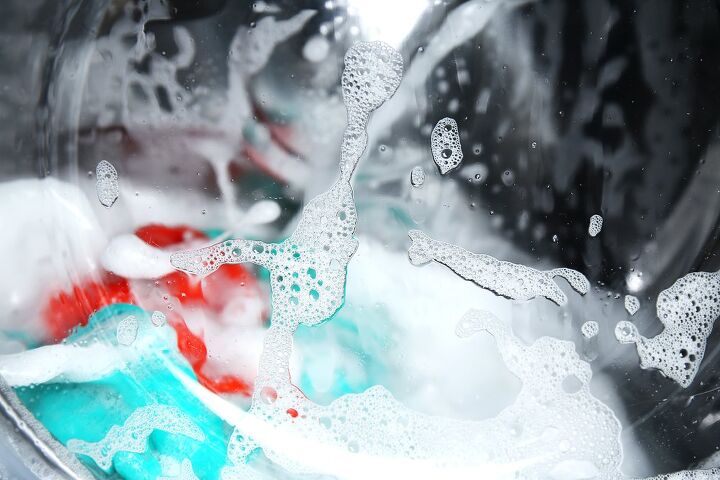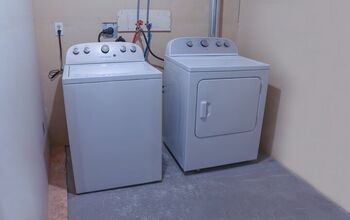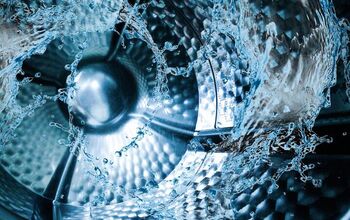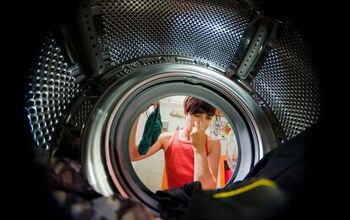Why Is My Washing Machine Not Rinsing Out All the Soap?

A malfunctioning washing machine can be a huge inconvenience, especially when the laundry starts to pile up. It can also cause worry that you might have to spend money on repairs or even purchase a new machine.
If your washing machine isn’t rinsing all the soap from your laundry, there are a few common causes. You might be using too much detergent, using the wrong kind of detergent, or overloading your machine. If those aren’t the problem, your washing machine might be in need of other repairs or cleaning.
Continue reading to learn why your washing machine might be leaving behind residue, and how to fix this problem.
Do You Need Appliance Repair Services?
Get free, zero-commitment quotes from pro contractors near you.

Common Mistakes That Cause Excess Soap in Your Laundry
Luckily, the problem of excess soap left in your laundry at the end of a wash cycle is usually an easy fix. Try correcting the common mistakes below to start getting fully rinsed laundry again.
You Used the Wrong Detergent
If you have a high-efficiency washing machine, you need to check your detergent bottle to make sure it’s HE, too. HE washers use less water, so they require HE detergent that doesn’t produce as many suds. Regular detergent is designed to produce more suds that will be left behind if used with an HE washer. In some cases, using regular detergent with an HE washer can even cause your washing machine to overflow.
To check if you are using the correct detergent, look for the “HE” symbol on your detergent bottle. It includes the lowercase “he” initials inside an oval or circle. It is usually dark blue in color.
It’s important to note that you can use HE detergent with a regular washing machine. If this is the case, using the wrong detergent may not be the problem causing excess soap in your laundry.
You Used Too Much Detergent
Using too much laundry detergent can also be a culprit for laundry with excess soap at the end of a cycle. As mentioned earlier, HE washers do require less water, and they also require less detergent to get your clothes clean. This is because, as the name suggests, they are designed to clean your clothes more efficiently than regular washing machines. So, the problem might be that you are using too much HE detergent with your HE washer.
Regardless of what washer type you have, you should ensure you are using the correct amount of detergent per load. Unfortunately, there is no magic quantity that will work every time. The correct amount of detergent varies between machines. It can also depend on how soiled the items are that need to be washed. Refer to the manual for your washing machine for the most accurate instructions on how much soap to use.
You Overloaded Your Washing Machine
It is always tempting to save time by filling up your washing machine to the brim. This is especially true when the laundry has been piling up for weeks. However, fewer loads might not actually save you time if your clothes come out soapy.
When you overload your washing machine, the items will not be moved around the tub as effectively as normal. Your machine needs a little bit of room in the tub to spin or tumble the clothing. This will allow the soap to distribute evenly, and allow the items to rinse thoroughly.
If your clothes are coming out soapy, try washing smaller loads at a time. Also, be sure to use the correct amount and type of laundry detergent, as described above.
Other Washer Components That Can Prevent Your Machine From Rinsing Properly
If you’ve corrected all potential user error problems that might be causing excess soap in your clean laundry, your washing machine might need other maintenance or repairs.
Clogged Filter
Did you know? Just like a lint filter on a dryer, your washing machine also has a filter that needs to be cleaned regularly. Small debris from clothing pockets, like coins and bobby pins can easily clog the filter. This can prevent your washing machine from functioning properly and might lead to improper rinsing of your laundry.
After ruling out any user error issues described above, a clogged filter is the next area to check. It’s another simple fix with just a few steps.
Here’s how to unclog your washing machine filter:
- Unplug your washing machine to safely clean your washing machine filter.
- Locate your filter if you haven’t already. The location varies between washers, but the filter can often be found at the bottom right corner of the front of the machine. It will look like a rectangular compartment.
- Remove the rectangular cover.
- Twist the filter to remove it, and clear any debris inside.
- Clean your filter with soap and water.
- Put the filter back into place, and test your washing machine for improvement.
To keep your washing machine functioning properly, check your washing machine filter at least once every two to three months.
Drain Pump
The drain pump is a component located underneath your washing machine that facilitates draining between cycles. This should be cleaned as often as every two months, though few washing machine owners probably clean it this often. If it’s been a while since you’ve cleaned your drain pump, it could be clogged with debris and buildup that is preventing proper drainage.
Here’s how to unclog your drain pump:
- Start by carefully turning your washer on its side or back to access the pump. Ensure that you know where it is located before you begin, as this can vary between washer types.
- When you locate your drain pump, disconnect it from the hose and remove it completely from the washer.
- The inlet port, which is the larger port located at the top of the pump, is usually the section that becomes clogged with debris. Pull out any debris with a pair of needle-nose pliers.
- If you find that your pump is damaged or broken due to debris buildup, order a new pump to install on your washer.
Drain Hose
Just like your drain pump, the drain hose can also become clogged with debris. Since it is attached to the drain pump, it can be easily checked for debris at the same time. The drain hose can be disconnected from the pump by releasing the clamps that are holding the hoses in place. Be sure to have a bucket or container in place to catch any water or debris when you disconnect it.
Another common problem that can occur is a bent drain hose, which can reduce the efficiency of rinsing. This can leave soap residue, and even cause dirty water to back up into the washing machine drum with your clothing. Be sure to periodically clean your drain hose as part of regular washing machine maintenance. Also, readjust it if it appears to have any bends that could restrict water flow.
Water Supply Hose
Your drain hose is the only hose on your washer that needs to be free of blockages. You should also ensure the hose which brings water to the washing machine isn’t bent, either. This is called the water supply hose. A bent water supply hose prevents the correct amount of water from being brought to your washing machine, leading to an imbalanced combination of water and detergent. This fix is as simple as repositioning the hose.
Water Supply Valves
Another issue that can prevent the correct amount of water from being delivered to your washing machine is a problem with the water supply valves. Behind your washer, you should find two water valves: one for hot water and one for cold water. Each of these should be fully open at all times, and any time you use your washing machine. If they aren’t fully open, your washing machine might not be getting enough water to properly complete the wash cycle.
Related Questions
Do You Need to Clean Your Washing Machine?
Yes, it is a good idea to clean your washing machine, and you should clean it more often than you might think. If your washing machine has a built-in cleaning cycle, you should use it as often as once per week, especially if you use your washing machine regularly.
Why Is My Washing Machine Leaving My Clothes Soaked?
A common cause for a washer leaving clothing soaked is a clogged or bent drain hose. A blockage means your washing machine cannot drain all the water properly at the end of the wash cycle. This will leave your clothes more soaked than usual.
Do You Need Appliance Repair Services?
Get free, zero-commitment quotes from pro contractors near you.

Conclusion
If your washing machine is not rinsing all of the soap out of your laundry, don’t jump to conclusions just yet. Instead of buying an all-new washing machine, try out some of the simple and inexpensive solutions listed above. In most cases, they’ll have your washer working like new again in no time!
Maybe, you’ve tried all of the solutions described above and you’re still experiencing problems. If that is the case, consider contacting a repair technician to take a look at your washer.

Dakotah Forbes is a copywriter and content writer specializing in home decor and design. She is dedicated to helping readers find answers to all their home design questions by creating helpful guides and articles. In her spare time, she loves to use her creative spirit to complete her own home decor and DIY projects. Dakotah graduated from James Madison University with a BA in Media Arts and Design and currently resides in Virginia with her husband.
More by Dakotah Forbes



























